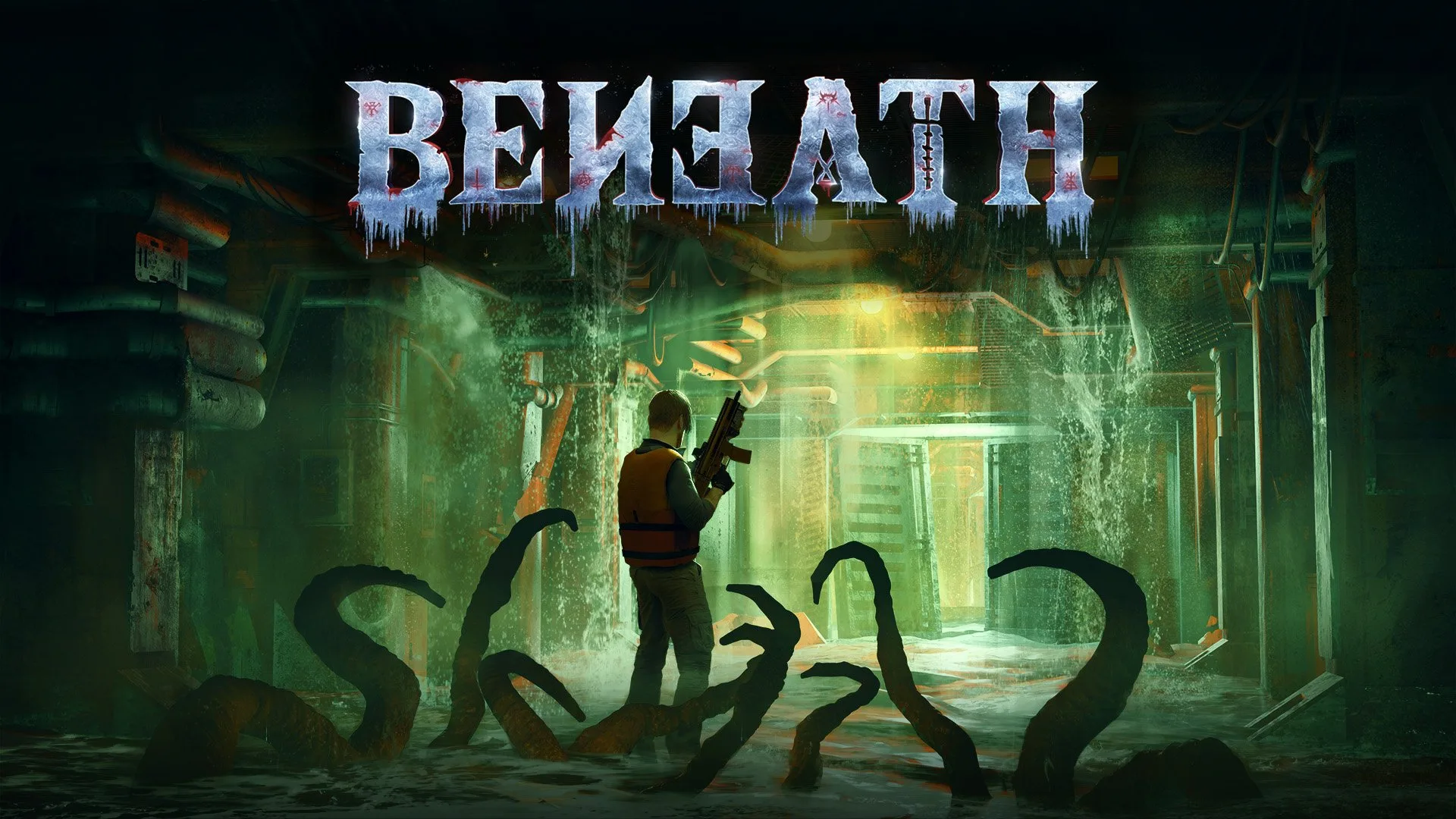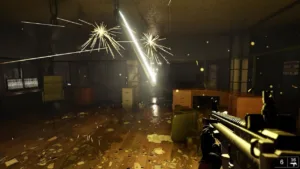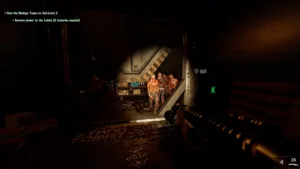The following review for Beneath, is written by GamesGuru1 aka Del.
Please welcome Del, who has recently joined the Complete Xbox Team, and we look forward to many more reviews from him down the line.
At Completexbox, we always welcome your views, and we love to share and promote them within the wider gaming community, so if you are interested in writing a guest review, please do get in touch.
First Impressions
Billed as a survival FPS with Lovecraftian-inspired setting and world, Beneath comes across initially as the evil spawn love child of Doom, F.E.A.R. and Alien: Isolation. Made as a passion project from a small development team, Zero Fraction Studios. The love is evident from the first moment you load up the game and the protagonist, Noah Quinn, is plonked onto the sea bed.
During my time with Beneath, as well as the obvious nod to all thing Lovecraftian, I definitely did also get Bioshock, as well as Quake vibes from the game. This is no means a problem as being compared to such standout giants in the genre can’t be a bad thing. Shades of Still Wakes The Deep and Hydrophobia creep in as you progress, adding to the tension and fear factor.
I Hope you like crawling through vents, as this game has more vent crawling than even John McClain could handle. Speaking of John McClaine, the gunplay is pretty solid too when it comes to the combat.
The game is best described as a story driven psychological FPS with Dead Space hallucinations and something that I haven’t seen since Eternal Darkness on the good old GameCube, a ‘Sanity’ metre were certain monsters or objects can directly affect your character’s sanity which makes aiming harder and you an easier prey. A unique game mechanic that fits into the narrative nicely as your character is no ‘one man army’ kinda guy, he’s just a regular Joe caught up in a impossible situation. And the game often reminds you of this as you progress.
Plot
Thanks to the Wired Creator Collective, I was gifted a copy of Beneath to review for launch. The game starts with the protagonist, Quinn, walking on the bottom of the sea heading towards a spookily and obviously haunted U-Boat submarine. However, no sooner do you make it there, a tremor happens and someone or something attacks your base ship above. Racing (as much as you can sprint in a diving suit), back there you find the crew dead by unseen hands and your daughter Amber who was on the ship missing. After trying to call for help from the ship’s radio, things continue to go from bad to worse as zombies and nightmarish creatures of the deep appear before your character finds himself back in the water. After passing out, you arrive at the underwater facility, and the real story of the game begins.
The story unfolds from here via various terminals and the emails you find on them, as well as tablets with voice messages left by personnel, with story updates shown on the loading screen too. There are also a few survivors to whatever happened before you arrived who show up on occasion, mainly to continue the story and give you a quest, most notably of these is the woman called ‘Nicole’ who has her own agenda and may or may not be as she seems.
Weird Eldrich like flashes that indicate a deeper story underneath what is initially presented to the player though, and what initially starts as a fairly simple ‘find your daughter and escape the underwater facility, evolves into something far more horrific. The enemies slowly turn from your standard human types to weird creatures straight out of your nightmares. The good thing is that this change is subtle and feels natural.
The flow of the story and how it descends into Lovecraftian madness makes sense and although I haven’t played the game to completion at the time of writing this review, I’ve got far enough to know the endgame will definitely be worth the punishment. And I’ll be sticking around for the ride til the end.
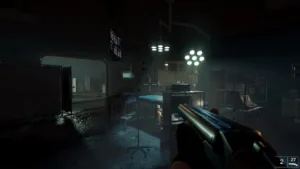
Gameplay Overview
Initially, the game options menu is short and functional, with only the usual New Game, Options and Credits initially. Options include Audio, with Volume Level while Control allows this gamer to invert the camera (which is usually the first option I change on a new FPS game), along with camera smoothing and sensitivity adjustment. Gameplay option is next with the standard subtitles, objective and waypoint on and off selection along with an option to turn ‘headbob’ on and off when holding a weapon. This is a nice touch I find as it’ll help many who has issues with motion sickness playing games by making the gunplay more rigid, at the expense of a bit of classic gun movement. This option selection is also where you can select the game’s difficulty from, which is by default set to the recommended level ‘Cold Reality’ or ‘Medium’ for the rest of us. Next, we have the Language options which offers quite a comprehensive list to choose from. Finally, the Credits option shows just how small a development team went into this game, with the same small number of names repeating often during the roll. This truly highlights that this was a passion project, and the creators knew exactly what kind of game they wanted to make.
Word of warning though. This game is HARD at times, often punishingly so in the first part, especially on the recommended difficulty setting of ‘Cold Reality‘. The developers have clearly gone for a challenging experience with Beneath, but this being one of its core strengths could also turn away a lot of more casual FPS players.
Level transition is fast and smooth, with loading kept to a minimum on current generation consoles. Both the Xbox Series X and the PlayStation 5 versions of the game load levels quickly with very little wait time. Making the game easy to engage with and pick up from where you last left off between gaming sessions.
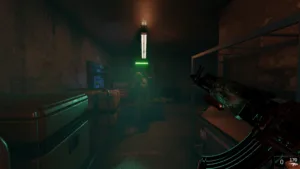
There’s no jump option in this game and sprint is managed by a stamina bar. I feel that this is by design as if you could run and jump over the environment constantly to escape the enemies then it would lower the fear factor during confrontations. It doesn’t stop you finding ways to climb over areas though. You’ll often find yourself in firefights with human soldiers in tight corridor spaces. You can crouch however, using B which you’ll be doing a lot of while using vents to access areas. Health syringes are mapped to ‘Y’ or ‘Triangle’ depending on your console of choice when they become available and trust me, you’ll be needing them. Up and Down on the ‘D-Pad’ is reserved for cycling through found weapons, which takes time. Grenades are mapped to your Right Bumper for ease of use and quick access when in combat, allowing you to instinctively lob one to help clear out groups of enemies. Most foes can be ‘looted’ after you kill them for ammo, which is in scarce supply for the most part. This makes you think about how you approach every encounter and try to make every single bullet count. Eventually also, you even get a crowbar so you can go full on ‘Gordon Freeman’ on the environment and enemies. Health is monitored on a handy dandy wristwatch you wear which can be views via the Menu screen. This also allows you to keep track of your weapons, ammo, grenades and health syringes.
The terminals mentioned earlier also allow you to unlock doors and disable systems to progress, along with keycards you find which have codes for certain doors between sections. However, the game will often not tell you what to do next apart from the usual head to somewhere or meet someone with only a floaty distance to target as a guide. I spent a good half hour on my initial first play of the game wandering around wondering how to unlock the door until I rechecked a terminal and found the option to unlock the door along the top. You can sometimes find yourself wandering wondering how to get to your next waypoint with no clear path, and with the lack of the aforementioned ability to jump, you can’t be ‘creative’ in making your way from A to B. With no in game map to call up, you reply on your own sense of direction and ‘You are here’ maps found on walls across the facility. The facility itself seems to be put together by the same people who built Rapture. With everything breaking down and exploding randomly, this often creates new paths and ways through the labyrinthic hallways of the facility you find yourself in.
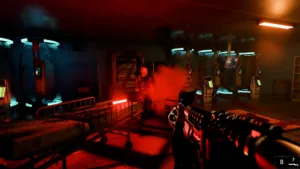
Only had one minor gripe during play, the weapon flashlight will switch off when you interact with a terminal, vent or item, resulting in you having to cycle your weapons back around in your inventory and clicking right on the ‘D-Pad’ again (each weapon can have it’s own flashlight flicked on and off manually) to get it to switch back on when leaving a vent, etc. This is a little inconvenience, especially with how the game is often very dark in areas, but hardly game breaking. Which I’m sure will be patched in a game update.
Every ammo and health pickup is strangely highlighted in neon green, which is great so you don’t miss important and valuable ammunition, crafting materials and such, however the games doesn’t make any effort to explain why, and it sticks out somewhat again the dark and atmospheric backdrop of the core game. Again, this is a small feature I personally picked up on and doesn’t mean it’ll feel like a problem for other players.
The game also has a fairly rugged personalisation of weapons option, via crafting upgrades to the weapons you find on your journey with workbenches scattered over the levels, along with weapon coatings to ‘pimp’ them out to your liking. Both upgrades and coatings require parts and kits you find around, which add to a totally number. Each enhancement costs an amount to ‘buy’ so it’s worthwhile hunting down as many as you can find. The ability to upgrade your guns becomes essential to progress as the enemies get tougher, but the weapon coatings are a nice touch to put your own personal stamp on your playthrough too.
Presentation
Despite this being an Indie title, the game is well presented and polished. It’s amazing to think the game was made by just two brothers and a small team but shows their love for the genre and all things first person horror. The general vibe is survival horror, with jump scares perfectly presented, but there’s more elements at play here and them more you progress, the more the game drags you in (quite literally). The difficulty spike at times forces you too adapt often on the fly and the enemy variety is good enough that there’s always some new nightmare just waiting round the corner to eat your face off. Fortunately, there’s a generous autosave feature so backtracking if you die is kept to relative minimum.
The Bottom Line
To close, Beneath is a fine addition to the rather sparce sub-genre of ‘horror FPS’ which hasn’t seen many titles since the classic F.E.A.R. series from years ago. The gameplay is tight, the gunplay is surprisingly weighty and the enemies and monsters you encounter being both tactical and horrific. If you’re looking for a challenging shooter that likes to play with your head, test your shooter skills and are willing to play with the lights off and the sound turned right up, then Beneath just might be the game for you. Apart from a couple of minor technical issues, I’m honestly able to recommend this for fans of the genre.
Overall
-
CX Score - 75%75%
Summary
Pros
- Solid FPS shooter goodness
- Good enemy variety
- Simple pick up and play mechanics
- Great claustrophobic atmosphere
Cons
- No jump button
- Next objective often hard to locate
- Difficulty spike can be frustrating
- Weapon select can feel sluggish

